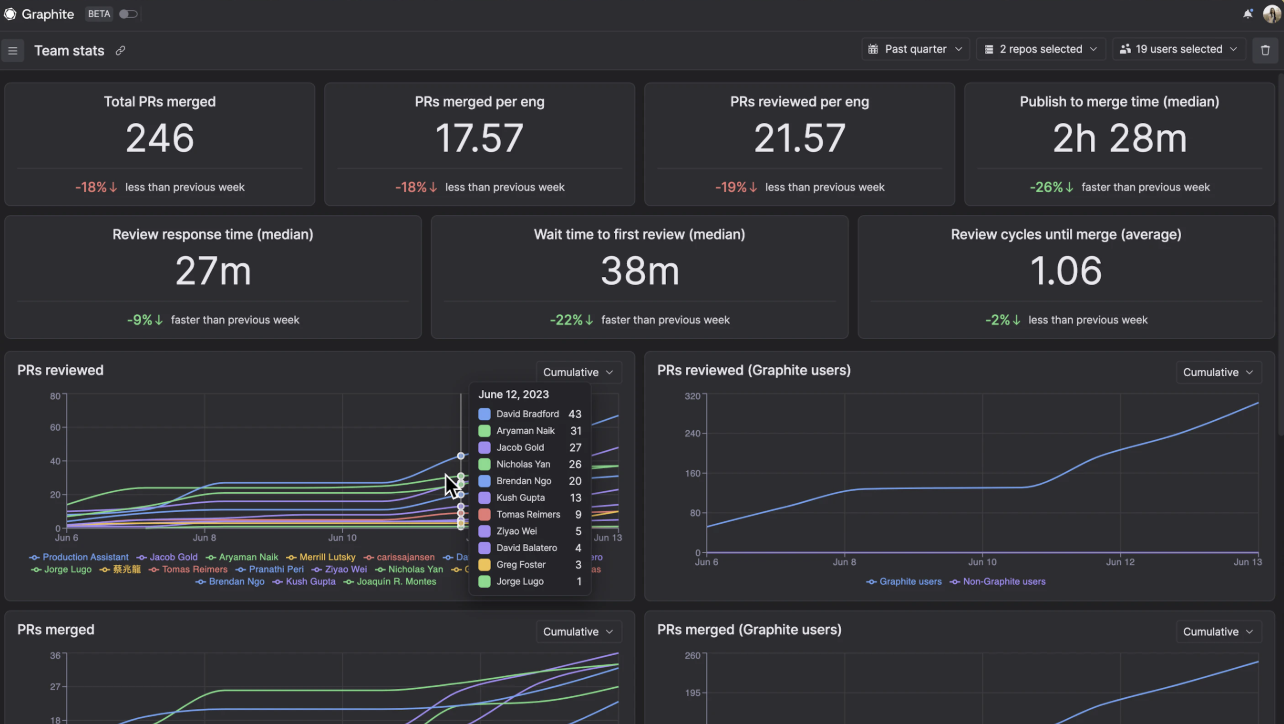Maintaining high code quality is of utmost importance, but it's often challenging. Various issues can arise, from code complexity problems to outdated libraries, affecting the efficiency and security of software. This guide will examine some of the most common code quality issues and how Graphite Insights can be used to identify and address these problems effectively.
Common code quality issues
Code complexity problems: Complex code can be hard to understand and maintain. It often leads to longer debugging and testing phases, which can delay releases. By using Graphite Insights, teams can monitor metrics like median review times and number of review cycles, which can indicate complex code that needs simplification.
Lack of coding standards: Without unified coding standards, projects can become a mess of inconsistent styles and practices. This inconsistency can make the code difficult to read and maintain. Here's an important resource on code quality guidelines for reference.
Poor code maintainability and readability issues: Maintainability refers to how easily software can be maintained to correct faults, improve performance, or adapt to a changed environment. Poor maintainability and readability can be spotted through metrics such as the frequency of revisions or the number of hotfixes applied, which Graphite Insights can provide.
Technical debt accumulation: Technical debt is a concept in software development that reflects the implied cost of additional rework caused by choosing an easy solution now instead of using a better approach that would take longer. High levels of technical debt can be flagged by an increase in the median time to merge PRs, a metric also available in Graphite Insights.
Insufficient code testing: Insufficient testing can lead to a higher incidence of bugs and security vulnerabilities. Graphite Insights can show the average number of PRs reviewed per person, helping teams ensure that enough attention is given to each piece of code before it is merged.
Security vulnerabilities in code: Security vulnerabilities can compromise the integrity and safety of an entire application. By monitoring the time taken to address pull requests that involve security fixes, development teams can prioritize and manage security-related code changes more effectively. This process ensures that vulnerabilities are addressed swiftly, minimizing potential risks and maintaining the security standards of the software
Performance inefficiencies and spaghetti code issues: Performance inefficiencies slow down the application, while spaghetti code refers to complex and tangled code structure. Insights can track changes to performance metrics over time, identifying PRs that introduce inefficiencies or complex code.
Code duplication concerns and outdated code libraries: Code duplication increases the maintenance burden, and using outdated libraries can introduce security risks into your software. Effective management tools help teams monitor the extent of duplicated code and track how frequently libraries are updated within their projects. This tracking aids in reducing redundancy and ensuring that dependencies are current, which in turn enhances both the security and maintainability of the application.
Lack of documentation and error-prone code sections: Documentation is crucial for new team members and for maintaining software long-term. Error-prone sections of code often lead to frequent bugs. Some code review tools can highlight areas of the codebase that lack adequate documentation or have high bug rates, guiding teams on where to focus their improvement efforts.
Software bug frequency: Frequent bugs can significantly diminish user satisfaction and trust in software. Monitoring tools that track the median time to fix bugs and the frequency of bug-related issues offer key data points that can guide teams in identifying and addressing the root causes of these bugs.
How Graphite Insights helps facilitate better code quality
Graphite Insights offers a suite of features designed to improve team efficiency and code quality:
- Customizable dashboards: Teams can create, save, and share views tailored to specific metrics, such as review response time or number of merged PRs.
- Time period flexibility: Analyze trends using predefined ranges (week, month, quarter, year) or define custom time frames.
- Granular filtering: Focus on individuals, teams, or specific repositories, ensuring precise insights into team performance.
- Trend analysis: Track historical data for up to two years, identifying persistent issues or improvements.
- Collaboration features: Share links to specific views with teammates for better collaboration and data-driven decision-making.
For example, by reviewing the metric "median wait time to first review," a team can identify bottlenecks in the review process and implement changes to improve responsiveness.

Why Graphite Insights stands out
Unlike generic code review tools, Graphite Insights focuses on making data actionable for teams of all sizes. It bridges the gap between engineering efficiency and code quality by offering transparency and customizability that other platforms lack. Whether tracking PR merge times, review cycles, or reviewer engagement, Insights empowers teams to deliver high-quality code with confidence.
Summary
Effective management of code quality is another part of success for any software project. By leveraging tools like Graphite Insights, teams can gain a clearer understanding of their code quality issues and implement strategic measures to mitigate them, leading to more robust, efficient, and secure software solutions.